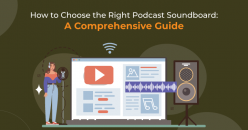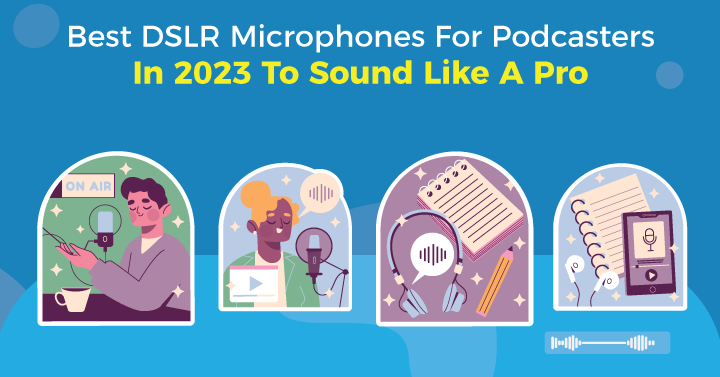
With more and more people turning to video podcasting to increase their audience, DSLR microphones are becoming an important piece of a podcaster’s equipment. That’s because while DSLR cameras can provide you with excellent picture quality, the built-in mics often leave a lot to be desired. The best DSLR microphones solve this problem by linking up seamlessly with your camera to supply an enhanced audio experience.
In this article, we’ll take you through some of the different types of DSLR mics available, from shotguns to lavaliers, with something for every budget.
1. How Can a DSLR Microphone Help?
Attaching an external microphone to your DSLR camera means higher-quality sound for your video podcast, as well as greater control over editing the feed, both live and in post-production. While the built-in DSLR mics are perfectly fine for home movies or even short YouTube clips, the reality is most podcast listeners have higher expectations when it comes to the level of audio.
2. Different Types of External Mics for DSLR
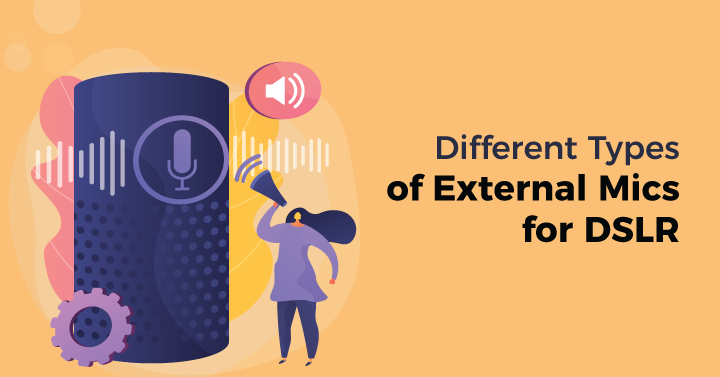
2.1 Handheld microphones
The classic handheld microphone is best for those who like to have something tactile to work with, particularly if you’re moving around a bit. While they are dubbed handheld, these mics can also be attached to a mic stand or boom arm for hands-free use – a far more useful setup for podcasters.
2.2 Lavalier microphones
Taking its name from a jeweled necklace pendant, the lavalier microphone is a high-quality device that is usually attached to the collar of clothing. It’s also known as a lav mic or a lapel mic. They are popular for video because they are unobtrusive on camera, but have the downside of being omnidirectional, meaning they are prone to picking up unwanted ambient sounds.
2.3 Shotgun microphones
Shotgun microphones are the preferred style of mic for many podcasters. They get their name from their elongated cylindrical shape that loosely resembles the barrel of a shotgun. This style of device tends to be highly directional, which is great for podcast recording since they won’t pick up much background noise. Shotgun mics often come with cold-shoe or hot-shoe mounts so they can be connected directly to a camera.
3. Features to Look at Before Selecting a DSLR Microphone
3.1 Size and weight
When selecting your DSLR mic, an obvious place to start is the size and weight. You don’t want anything that’s so chunky it takes up most of the screen in your video podcast. Plus, if your podcast is sometimes recorded outside a regular studio, you don’t want something bulky that you’ll have to lug about everywhere.
3.2 Polar pattern
The polar pattern is the space around a microphone that picks up sound. There are three main types commonly in use. The most popular pattern for podcasts tends to be the cardioid, named because it loosely resembles a heart shape. Cardioid mics are most sensitive to sound coming from the front, while eliminating sound from the sides and back. Really tightly focused variations are known as supercardioid and hypercardioid.
Bidirectional mics concentrate on noises in the front and the rear, while blocking noise from the sides. Also known as a figure of 8 mic, they can be useful if you want to save a bit on mic costs and have a setup where two hosts or a host and an interviewee are facing one another.
Omnidirectional mics pick up sound from everywhere. They are less common for podcast recordings because they absorb a lot of ambient noise, though they can be useful for live performances where you want to capture audience reactions.
3.3 Battery life
The last thing anybody wants is for their microphone to die halfway through a recording. Most mics these days have long battery lives, but it’s worth taking note of whether a device has rechargeable internal batteries, AA batteries or USB ports that allow you to plug directly into the mains.
3.4 Condenser or dynamic
There are two main types of microphones, each operating according to different laws of physics. Without getting into too much technical detail, condenser mics are more sensitive and capture a higher quality of sound. However, they also require a power source to function and are less durable than the alternative, a dynamic mic.
Dynamic mics are hardy, don’t require a power source, and tend to be cheaper compared to condenser mics. While they don’t capture high-frequency sound particularly well, their comparative lack of sensitivity can sometimes be useful for podcasters who are worried about background noise.
3.5 Frequency response
The frequency response refers to the range of frequencies a device can reproduce. For microphones, this generally ranges from 20Hz to 20kHz. A flat response mic is sensitive to all frequency ranges. A shaped response mic, on the other hand, is designed to be more attuned to a narrower frequency range, which can be useful in reducing background noise.
3.6 Budget
Cost is always something to consider when choosing a mic. Even though you may want to purchase one of the best DSLR microphones on the market, the prohibitive cost of these models may nudge you more towards seeking out the best budget DSLR microphone options available.
4. The 13 Best DSLR Microphones
4.1 Rode VideoMic Pro
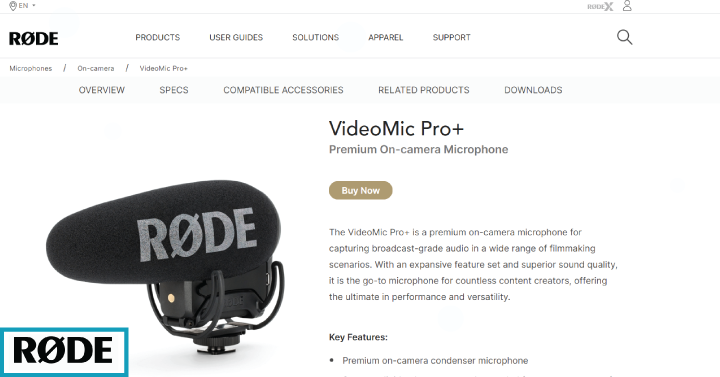
Kicking off this list of the best DSLR microphones, the Rode VideoMic Pro is a lightweight condenser microphone with a super cardioid polar pattern that is ideal for capturing crisp directional audio without any ambient noise.
There are several features built in to ensure you achieve an optimal sound, including a high-pass filter, three-stage gain control, integrated shock mounting, and a windscreen. Boasting a 9-volt alkaline battery that provides 70 hours of power, you can feel secure in the knowledge that this shotgun mic won’t suddenly run out of juice.
Weight and size: 85g, 100 x 75 x 170mm
Polar pattern: Supercardioid
Battery life: 70 hours
Microphone type: Condenser
Frequency range: 40Hz-20kHz
Connectivity: 3.5mm TRS
Price: $229
4.2 Shure VP83F LensHopper
Another of the best DSLR microphones in a supercardioid condenser package, the shotgun-style Shure VP83F LensHopper has an integrated recording function that allows you to store WAV files on a microSD card.
The radio frequency (RF) immunity protects against interference from mobile devices, with an integrated shock mount and a foam windscreen to minimize vibration and wind noise. Using a five-position joystick, you can control the low-cut filter, gain and playback. Shure VP83F takes two AA batteries, which supply up to 10 hours of power.
Weight and size: 215g, 84 x 43 x 150mm
Polar pattern: Supercardioid
Battery life: 10 hours
Microphone type: Condenser
Frequency range: 50Hz-20kHz
Connectivity: 3.5mm TRS
Price: $299
4.3 Rode VideoMic Pro+
This Rode DSLR mic is essentially a beefed-up version of the Rode VideoMic Pro for those with a bit more of a budget. In addition to the high-pass filter, three-stage gain control, integrated shocking mounting and optimized windscreen, it also has a high-frequency boost function to enhance sound clarity, as well as a rechargeable lithium battery that can last up to 100 hours. Alternatively, you can power the mic using AA batteries or a USB power cable.
Weight and size: 122g, 111 x 66 x 170mm
Polar pattern: Supercardioid
Battery life: 100 hours
Microphone type: Condenser
Frequency range: 40Hz-20kHz
Connectivity: 3.5mm TRS
Price: $299
4.4 Comica CVM-V30 LITE
In the running for the best budget DSLR microphone, the Comica CVM-V30 LITE is a shotgun condenser mic with a supercardioid polar pattern. While the frequency range is slightly more limited and the sound quality isn’t of the same caliber as the Rode VideoMic Pro or the Shure VP83F LensHopper, it’s a lot cheaper.
Despite being in the low-cost category, it still has a solid shock mount and anti-RF interference. This model doesn’t have its own batteries, which on the one hand means it’s lighter, but on the other means it will be leeching off your DSLR.
Weight and size: 52g, 160 x 50.8 x 86mm
Polar pattern: Supercardioid
Battery life: N/A
Microphone type: Condenser
Frequency range: 60Hz-20KHz
Connectivity: 3.5mm TRS
Price: $36.99
4.5 Deity V-Mic D3 Pro
One of the most unique features of the Deity V-Mic D3 Pro is its stepless analog gain knob, which allows you to incrementally adjust the gain. This supercardioid condenser mic also has two levels of low-cut filter as well as a rechargeable lithium ion battery that can last up to 51 hours. The device comes with a foam windscreen as well as an adjustable cold-shoe shock mount.
Weight and size: 143g, 241 x 124 x 83.1mm
Polar pattern: Supercardioid
Battery life: 51 hours
Microphone type: Condenser
Frequency range: 50Hz-20kHz
Connectivity: 3.5mm TRRS
Price: $139
4.6 Sennheiser MKE 600
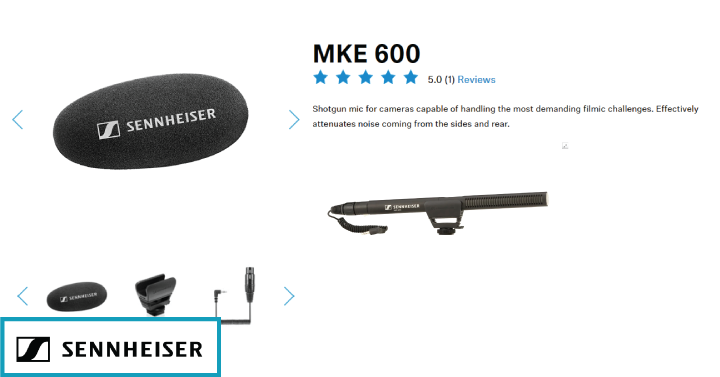
Sennheiser’s MKE 600 certainly isn’t cheap, but it’s one of the best DSLR microphones out there for people who are obsessed with purity of sound. As with all supercardioid condenser mics, this shotgun-style device is highly directional and highly sensitive, with a low-cut filter switch to minimize air noise. You can choose whether to power the mic using phantom power or a single AA battery, which can keep the device going for up to a whopping 150 hours. The MKE 600 comes with a foam windscreen, shock mount and TRS jack.
Weight and size: 128g, 256 (length) x 20mm (diameter)
Polar pattern: Supercardioid
Battery life: 150 hours
Microphone type: Condenser
Frequency range: 40 Hz-20 kHz
Connectivity: 3.5mm TRS
Price: $318
4.7 Saramonic Vmic Recorder
The Saramonic Vmic Recorder features an LCD screen that keeps you in the loop with regards to audio levels, battery life and recording time. This shotgun mic allows you to record 6-bit, 48kHz WAV audio files to a MicroSDHC, and you can monitor your incoming audio through the stereo headphone output. A pair of AA batteries will give you a relatively measly 8 hours of recording time, though that should still be plenty for most podcasters.
Weight and size: 209g, 255 x 66 x 80mm
Polar pattern: Supercardioid
Battery life: 8 hours
Microphone type: Condenser
Frequency range: 50Hz-20kHz
Connectivity: 3.5mm TRS
Price: $79.95
4.8 Movo VXR10-PRO
Another excellent budget option, the Movo VXR10-PRO is a shotgun condenser mic with a supercardioid polar pattern. It comes with a shock mount and windscreen, but no sound adjustment features. Like the Comica CVM-V30 LITE, it relies on the DSLR camera for power. This model of Movo also supports headphone monitoring.
Weight and size: 60g, 100 (length) x 26mm (diameter)
Polar pattern: Supercardioid
Battery life: N/A
Microphone type: Condenser
Frequency range: 20Hz-18kHz
Connectivity: 3.5mm TRS/TRRS
Price: $49.95
4.9 Rode Smartlav+
For something more portable and discreet, the Rode Smartlav+ is one of the best DSLR microphones on the market. A lavalier microphone with an omnidirectional polar pattern, it comes with a pop filter to minimize plosives.
This model is principally designed for use with a smartphone for the ultimate portable combo, but you can purchase an adapter to use it with a DSLR. There is no internal battery, so the lavalier cable will have to run from the camera to your lapel.
Weight and size: 6g, 1,180 x 4.50 x 4.50mm (length includes cable)
Polar pattern: Omnidirectional
Battery life: N/A
Microphone type: Condenser
Frequency range: 20Hz-20kHz
Connectivity: 3.5mm TRRS
Price: $79
4.10 Shure VP64A
If you’re looking for the best wireless mic for DSLR cameras, the hand-held Shure VP64A should certainly be in the mix. This dynamic mic has a frequency response that’s tailored to the mid-range, so as to optimize speech clarity – ideal for podcasters. It comes with an internal isolation mount to reduce any handling noise and a windscreen to diminish the sound of pops.
Since it’s dynamic, there’s no need to worry about battery life, while the omnidirectional polar pattern means you could even purchase just one for a pair of speakers seated facing one another.
Weight and size: 158g, 200 x 19 x 38mm
Polar pattern: Omnidirectional
Battery life: N/A
Microphone type: Dynamic
Frequency range: 50Hz-12kHz
Connectivity: Wireless
Price: $89
4.11 Canon DM-E1
Canon’s DM-E1 shotgun mic has three different directional settings for you to experiment with while recording your podcast, including monaural mode (highly directional), a 90-degree polar pattern and a 120-degree polar pattern. The camera is powered by a lithium battery that can provide up to 100 hours of usage. A windscreen and a shock mount are included in the bundle.
Weight and size: 110g, 40 x 84 x 130mm
Polar pattern: Cardioid
Battery life: 100 hours
Microphone type: Condenser
Frequency range: 50Hz-16kHz
Connectivity: 3.5mm TRS
Price: $249
4.12 Rode VideoMic NTG
Like the other Rode VideoMics detailed above, the Rode VideoMic NTG DSLR mic features a supercardioid polar pattern, a high-pass filter and a high-frequency boost. What sets this model apart is its infinitely variable gain control, which allows you to finely tune the mic signal strength to increase or decrease volume. This shotgun condenser mic also has an auto-sensing 3.5mm output that can work with either a camera or a smartphone without the need for an adaptor.
Weight and size: 94g, 171 (length) x 21.66mm (diameter)
Polar pattern: Supercardioid
Battery life: 30 hours
Microphone type:
Frequency range: 20Hz-20kHz
Connectivity: 3.5mm, USB-C
Price: $249
4.13 Rode RodeLink Wireless Filmmaker Kit
The RodeLink Wireless Filmmaker Kit is a DSLR mic wireless package featuring a transmitter, a receiver and a lavalier mic. With these three pieces of equipment (plus some AA batteries), you can record your podcast wirelessly without the need to create an overly complicated setup. The receiver can be attached to any standard camera shoe mount, while the transmitter can be fitted discreetly to a belt, with the lav mic cable running up to your lapel.
Weight and size: 6g, 1,200 x 4.5 x 4.5mm (length includes cable)
Polar pattern: Omnidirectional
Battery life: 30 hours
Microphone type: Condenser
Frequency range: 35Hz-22kHz
Connectivity: Wireless
Price: $449.99
5. FAQs
- Do you need a microphone for a DSLR camera?
The short answer is, yes. If you want to create a video podcast with a degree of professionalism, you will need an external microphone for your DSLR camera. After all, why invest money in getting a good quality picture if you’re just going to churn out mediocre sound?
- What is the highest quality microphone in the world?
Determining the highest quality and best DSLR microphones in the world is a big ask! However, there are a few contenders for the title. For wireless work, the Shure VP64A is tailored for recordings involving speech. While Rode has loads of solid options, the VideoMic NTG has proven itself particularly popular with podcasters.

